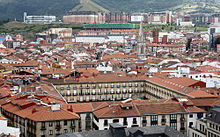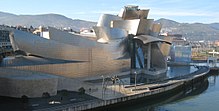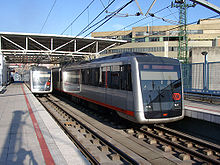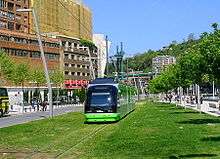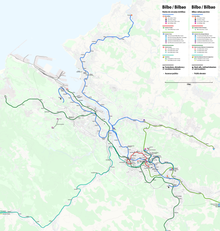Bilbao
| Bilbao | ||
|---|---|---|

|
||
| coat of arms | Map of Spain | |

|
|
|
| Basic data | ||
| Autonomous Community : | Basque Country | |
| Province : | Bizkaia | |
| Comarca : | Gran Bilbao | |
| Coordinates | 43 ° 15 ′ N , 2 ° 55 ′ W | |
| Height : | 8 msnm | |
| Area : | 41.26 km² | |
| Residents : | 346,843 (Jan 1, 2019) | |
| Population density : | 8,406.28 inhabitants / km² | |
| Founding: | June 15, 1300 | |
| Postal code : | 48001-48015 | |
| Municipality number ( INE ): | 48020 | |
| Nearest airport : | Bilbao airport | |
| administration | ||
| Official language : | Spanish, Basque | |
| Mayor : | Juan María Aburto ( PNV ) | |
| Website : | www.bilbao.eus | |
Bilbao ( Basque also Bilbo ) is the capital of the province of Bizkaia (Spanish: Vizcaya ) and the largest city of the Autonomous Community of the Basque Country in Spain. At the same time, Bilbao is one of the university cities in Spain.
It is also the most important industrial and port city in the Basque Country and, plus the surrounding area, has almost 900,000 inhabitants. With 346,843 inhabitants in the urban area, Bilbao is one of the ten largest cities in Spain .
geography
The city is located on the Ría de Bilbao , which flows into the Bay of Biscay ( Cantabrian Sea ) at Portugalete . In Basauri , the Nervión and Ibaizabal rivers (Basque for broad river ) join and flow from there together into the Ría. The tidal limit is in the old town, around the San Antón Bridge.
City structure
The city of Bilbao is divided into a total of eight so-called “Distritos” (German districts). These are in detail:
- Deusto
- Uribarri
- Otxarkoaga Txurdinaga
- Begoña
- Ibaiondo
- Abando
- Rekalde
- Basurto – Zorroza
history
Late Middle Ages and Early Modern Times
Diego López V de Haro founded the city at the mouth of the Nervión in the area of the predecessor church of Begoña on June 15, 1300. The legal basis was that written on June 15, 1300 in Valladolid and on January 4, 1301 by Ferdinand IV of Castile and León in Burgos confirmed founding letter ( carta puebla ). In the introduction to this letter of foundation it says:
In the nombre de Dios é de la vgen vienaventurada Sancta María. Sepan por esta carta quantos la vieren é oieren como yo Diego Lope de Haro, sennor de Vizcaia, en uno con mi fijo Don Lope Diaz é con placer de todos los vizcaynos, fago en Bilvao de parte de Vegonna nuevamente población é villa qual dizen el puerto de Bilvao ... ( Eng .: In the name of God and the Blessed Blessed Virgin Mary. Know that through this letter, if you may see it or hear about it, as I, Diego Lope de Haro, Count of Vizcaya, agree with to my son Don Lope Diaz and to the delight of all Vizcaynos, I am making anew in Bilvao on the part of the Vegonna (Begoña) a town and municipality that should be called the port of Bilvao ...
Previously here u. a. a Roman settlement called Bellum Vadum already exists. This should be through the intermediary Bilbaum have sanded the present city name, one that in Bilbao on German of Nice ford could speak. Other theories lead the name back to the Basque bi albo (English: two sides, referring to the two banks of the ría ) or to the Biribilbao castle , which was located near the church of San Anton.
At the time of its founding, where Bilbao la Vieja stands today, was a small village of iron smiths, sailors and farmers. The first streets of Bilbao were Somera, Artekale and the Tenderia.
Agriculture disappeared over time, but iron and the sea have remained the defining elements of Bilbao throughout history. The high-quality iron ore from the nearby mines was already valued and exploited by the Romans. The fact that the Ria is navigable to a large extent made it possible to load Castile's goods for export to Europe in the port in it, which was safer than those on the coast.
A product of the Bilbao iron industry, even if it is not a very laudable one, has even found its way into world literature. In Shakespeare's Hamlet it says: “Methought I lay worse than the mutinies in the bilboes.” Bilboes are iron bars to which the sailors were tied with their feet as punishment.
In 1511 Bilbao was given the right to set up its own commercial court , which was allowed to issue legal provisions in the form of ordinances. The last of these ordinances, which was promulgated in 1737, formed the basis for the first Spanish commercial code of 1829. In the 18th century, Bilbao prospered primarily through intensive trade with the Spanish colonies in America.
19th century
Bilbao was badly damaged in the wars with France. After the Battle of Ormea on July 17, 1795, and then again on September 26 and November 1, 1808 , it was captured by the French under Ney and Lefevre, after which the French occupied it throughout the war until 1813.
On October 3, 1833, a revolt broke out in Bilbao in favor of Don Carlos , who declared himself King of Spain the following day. The city was occupied again on November 24, 1833 by the troops of the regent Maria Christina , who were under the command of Pedro Sarsfield . In the summer of 1835, Bilbao was besieged in vain by the Carlist led by Zumala-Carreguy, who died here. On October 23, 1836, the city was surrounded and bombarded again. Despite the consequent destruction of parts of Bilbao and the hardship prevailing in the city, the besieged resisted violently until they were appalled by General Baldomero Espartero on December 24, 1836 . Thereupon it became with the port city Portugalete the central point from which the English supported Maria Christina's troops. The city received the title "The Undefeated".
The increasing importance of Bilbao prompted English capitalists to build a port on the eastern bank of the Bilbao bosom to make the city accessible to larger ships. However, the execution was delayed by the third Carlist War, the scene of which from the beginning of 1874 had primarily been the province of Vizcaya. Bilbao itself, which had a garrison of only 4,700 men, was attacked by 20,000 Carlists under General Elio at the end of 1873 and, after an attempt at relief by General Moriones had been repulsed on December 25, was trapped after the capture of Portugalete (January 22, 1874). Don Carlos made every effort to conquer the city, as it was to become his coronation city and residence. In February and March 1874 he had them shot at several times. The government troops tried twice in vain to storm the ruling position of the Carlist on Somorrostro: Moriones on February 23 and 24, Serrano on March 25 and 27. Finally after several days of fighting from April 28th to May 2nd, 1874, Concha managed to bypass the enemy position, to force the Carlist to withdraw and to relieve Bilbao. Even later, the Carlist made several unsuccessful attempts to seize Bilbaos.
Even if the construction of the first blast furnaces had already started in the middle of the 19th century, the development of Bilbao should only really start after the last siege in the Carlist War in 1874. At that time, the municipal districts of Abando and Begoña united, the planned expansion ( El Ensanche ) of the city center based on Barcelona took place , and such important buildings as the Arriaga theater, the stock exchange or the Alhóndiga (former wine and spirits warehouse) were built . In 1877 Bilbao had 32,000 inhabitants, this number rose to 83,000 in 1900. The wealthy part of the population oriented culturally to England and the local economic liberalism ; English-style gentlemen's clubs emerged such as La Bilbaína , El Naútico and El Marítimo . The industrial development on the estuary, the establishment of ironworks and shipbuilding companies, boosted banking and trade and made Bilbao the capital of the Basque economy.
From the 20th century
Electrification began in 1883, and by 1894 there were already around a thousand telephone connections. In 1897 the institutes of higher education Instituto del Hierro y del Acero and the Escuela de Ingenieros Industriales de Bilbao were founded, followed in 1916 by the Universidad Comercial de Deusto at the Universidad de Deusto founded in 1886 . The name goes back to the location of the university in Deusto, which is now part of Bilbao. Thus Bilbao is one of the Spanish university cities. The development into a large university with private, Jesuit sponsorship led to a connection with the University of San Sebastian. Today both have the common name Universidad de Deusto en Bilbao y San Sebastián .
During the Spanish Civil War , the vast majority of the population of Bilbao were on the side of the Second Spanish Republic , which had granted the Basques extensive rights of autonomy. The victory of the Franquists put an end to this self-determination and, in the final phase of the dictatorship, mobilized political support for Basque separatism well into the bourgeois-capitalist social classes. The industrial decline from the 1970s had made itself felt in the region. However, the city managed to diversify its economic activities and, since the early 1990s, get rid of the image of an ugly, gray, dirty city that had clung to it for decades.
The boom now known as the Bilbao effect (also: the “Guggenheim effect”) put the industrial city of Bilbao, which was burdened by high unemployment, into a prosperous frenzy and also had an impact on the whole country. The prerequisite was the integration of the heterogeneous districts stretching over 15 kilometers along the mouth of the Nervión funnel, which, incoherently, as in Wuppertal , hardly created any urban identity before the construction of the suspension railway . An important element of the modernization was the metro line planned by Sir Norman Foster . Their puristic design received a "declaration of love": the Bilbaínos christened the disposals "Fosteritos".
climate
The climate in Bilbao is determined by the humid sea air, which is influenced by the ocean currents, with mild temperatures almost all year round. The wind forces are higher in spring or autumn. The mean temperature is 21 ° C in summer and 9 ° C in winter. With 1200 mm of precipitation per year, Bilbao is one of the wettest cities in southern Europe.
| Bilbao | ||||||||||||||||||||||||||||||||||||||||||||||||
|---|---|---|---|---|---|---|---|---|---|---|---|---|---|---|---|---|---|---|---|---|---|---|---|---|---|---|---|---|---|---|---|---|---|---|---|---|---|---|---|---|---|---|---|---|---|---|---|---|
| Climate diagram | ||||||||||||||||||||||||||||||||||||||||||||||||
| ||||||||||||||||||||||||||||||||||||||||||||||||
|
Average monthly temperatures and rainfall for Bilbao
Source: Bilbao climate table (from the Astronomical Association); AEMET
|
|||||||||||||||||||||||||||||||||||||||||||||||||||||||||||||||||||||||||||||||||||||||||||||||||||||||||||||||||||||||||||||||||||||||||||||||||||||||||||||||||||||||||||||||||||||||||||||||||||
Population development
In 1970 Bilbao was the sixth largest city in Spain and had 410,490 inhabitants, by 1981 the population increased to 433,115, but thereafter it decreased to 353,567 inhabitants by 2003 and further to 345,122 inhabitants in 2016.
politics
Bilbao is the only capital of a province in the whole of the Basque Country where Basque nationalism has ruled continuously since 1979. Since then, the nationalist party EAJ-PNV has ruled the city. Juan Maria Aburto Rike (EAJ-PNV) has been Mayor of Bilbao since 2015, who governs together with the social democratic party PSE-EE .
The municipal council consists of 29 elected members. These are elected in a party's list. Only parties with 5% or more of all valid votes may join the municipal council. The mayor is elected by the 29 members and has to be one of these members himself. The latest election results for the Bilbao Municipal Council are as follows:
| Political party | be right | Seats |
|---|---|---|
| EAJ-PNV | 71,822 (42.7%) | 14th |
| PSE-EE | 26,783 (15.9%) | 5 |
| EH Bildu | 25,138 (14.9%) | 4th |
| Elkarrekin Podemos | 17,661 (10.5%) | 3 |
| PP | 15,441 (9.2%) | 3 |
Was elected Juan Maria Aburto Rike with the 14 voices of the EAJ-PNV and PSE-EE 5. The government is supported by 19 out of 29 members.
Attractions

In the 1990s, Bilbao, which was previously off the beaten track, undertook a far-reaching redesign of its inner city. So a 28 km long metro line was built by 1995, almost all of whose stations were designed by Sir Norman Foster .
Another new building is the Zubizuri bridge by the architect Santiago Calatrava , which is modeled on an inflated sail.
Center of tourist interest, besides the oldest transporter bridge in the world, the Puente de Vizcaya across the River Nervion (also Puente Colgante "Hanging Bridge") set up to 1997 to plans by the US architect Frank O. Gehry built the Guggenheim Museum Bilbao . The spectacular museum building made of titanium, glass and limestone is one of the most important examples of avant-garde architecture of the 20th century worldwide. The museum corresponds to the otherwise often faceless, industrial shape of Bilbao by “enclosing” the neighboring Puente La Salve with its walls. The focus of the collection is modern and contemporary art, which is shown in changing exhibitions. In front of the museum is a work of art by Jeff Koons , the "Puppy", which is planted with flowers and should only be there in the opening year. After protests by the population, the puppy was allowed to stand in front of the Guggenheim Museum and is replanted with flowers every spring, which are continuously exchanged when they have faded.
For tourists in the shadow of these new buildings is the lively old town of Bilbao, characterized by narrow streets, the Casco Viejo , with the Siete Calles (the seven streets) and the medieval Gothic Catedral de Santiago from the 14th century. The city center has an architecturally interesting mix of old and new buildings in different styles.
Other museums are:
- the Museo de Bellas Artes "Museum of Fine Arts", one of the most important public art museums in Spain,
- the Museo Etnográfico Vasco "Basque Museum" located in the Casco Viejo "old town ",
- the Museo Marítimo Ría de Bilbao ("Maritime Museum ") with an exhibition, an outdoor area with a dry dock , several small ships and a 30-ton crane as well
- the still young Museo de la Industria "Industrial Museum " in Portugalete.
Another important attraction is the Begoña Basilica ( Basílica de Ntra. Sra. De Begoña ).
The colorful mixed cityscape can be described as innovative as well as unregulated, in all cases the result is a lively city that is worth seeing. The many parks and green spaces on the slopes adjacent to the city center, which can be quickly reached on foot from the center and provide a unique view of the city, contribute in particular.
In Bilbao, the extremely popular football club Athletic Club , which traditionally has only Basque players, plays an important role.
In 1917 the German School Bilbao , the Colegio Alemán San Bonifacio , was founded as a bicultural meeting school.
Portal of the Catedral de Santiago in the heart of the Casco Viejo "old town"
The Zubizuri Bridge
traffic
The main carriers of public transport are the Bilbao Metro (underground) and the EuskoTren tram line . There are also several bus routes operated by Bilbobus and BizkaiBus .
The Bilbao Airport is not on the territory of the city itself, but four kilometers north in place Loiu. There is a bus shuttle from the airport to Bilbao.
Town twinning
City partnerships exist between Bilbao and
-
 Bordeaux , France , since 2000
Bordeaux , France , since 2000 -
 Buenos Aires , Argentina , since 1992
Buenos Aires , Argentina , since 1992 -
 Medellín , Colombia , since 1998
Medellín , Colombia , since 1998 -
 Pittsburgh , USA
Pittsburgh , USA
-
 Qingdao , People's Republic of China , since 2006
Qingdao , People's Republic of China , since 2006 -
 Rosario , Argentina , since 1988
Rosario , Argentina , since 1988 -
 Sant Adrià de Besòs , Spain (with the district of San Adrián )
Sant Adrià de Besòs , Spain (with the district of San Adrián ) -
 Tbilisi , Georgia , since 1989
Tbilisi , Georgia , since 1989 -
 Milan , Italy , since 2011
Milan , Italy , since 2011
sons and daughters of the town
- Juan Bautista de Poza (1588–1659), theologian, Jesuit and author
- Juan Crisóstomo de Arriaga (1806–1826), composer
- Miguel de Unamuno (1864-1936), philosopher
- Andrés Isasi (1890–1940), composer
- Pichichi (1892-1922), football player
- José Antonio Aguirre (1904–1960), politician
- Pedro Arrupe (1907-1991), Order General
- Tomás Blanco (1910–1990), actor
- Blas de Otero (1916–1979), poet
- José Arribas (1921–1989), football coach
- Juan Xiol Marchal (1921–1977), film director and screenwriter
- Luis Mario Martínez de Lejarza Valle (1922–1980), Jesuit, auxiliary bishop in Guatemala
- Ramiro Pinilla (1923-2014), writer
- Juan Ángel Belda Dardiñá (1926-2010), bishop
- Ricardo Díez-Hochleitner (1928–2020), President of the Club of Rome
- Wladimiro Bas Zabache (* 1929), jazz musician
- Jesús Garay (1930–1995), football player
- Luis de Pablo (* 1930), composer and music teacher
- Joaquín Achúcarro (* 1932), pianist and music teacher
- Jon Cortina (1934-2005), Spanish Salvadoran Jesuit and human rights activist
- Fritz Rudolf Fries (1935–2014), German writer and translator
- Pedro Olea (born 1938), director
- Jesús Mosterín (1941–2017), philosopher
- Iñaki Sáez (* 1943), football player and coach
- Joaquín Almunia (* 1948), politician
- Carlos Ruiz Herrero (born 1948), football player
- Josu Ortuondo Larrea (* 1948), politician
- Fernando Maura (* 1955), politician and author
- Joseba Segura Etxezarraga (* 1958), Roman Catholic auxiliary bishop in Bilbao
- Juan Manuel López Iturriaga (born 1959), basketball player
- Wolfgang Ratz (* 1959), writer
- Tomás Saldaña (* 1961), racing car driver
- Fernando Grande-Marlaska (* 1962), judge and politician
- Miguel Olaortúa Laspra (1962–2019), Catholic religious, Vicar Apostolic of Iquitos in Peru
- Julio Salinas (born 1962), football player
- Jaime Smith Basterra (* 1965), CEO of O₂ Germany
- Álex de la Iglesia (* 1965), film director and screenwriter
- Kepa Junkera (* 1965), musician and composer
- Francisco Javier García Gaztelu , alias Txapote (* 1966), former leader of the ETA
- Rafael Alkorta (* 1968), football player
- Patxi Xabier Lezama Perier (* 1967), sculptor and writer
- Aitor Larrazábal (born 1971), football player
- Javier Salinas (* 1972), writer
- Alberto Berasategui (* 1973), tennis player
- Mikel Garikoitz Aspiazu Rubina (* 1973), alleged leader of the ETA
- Tontxu (* 1973), songwriter
- Espido Freire (* 1974), writer
- Gaizka Mendieta (* 1974), football player
- Javier Otxoa Palacios (1974-2018), racing cyclist
- Izaskun Bengoa (* 1975), racing cyclist
- Gaizka Garitano (* 1975), football player
- Mattin (* 1977), improvisation musician and author
- Francisco Yeste (* 1979), football player
- Javier Casas (* 1982), football player
- Igor Angulo (* 1984), football player
- Jon Kortajarena (* 1985), model
- Miguel Mínguez (* 1988), racing cyclist
- Ander Herrera (* 1989), football player
- Iñaki Williams (born 1994), football player
- Juan Del Campo (* 1994), ski racer
Web links
Individual evidence
- ↑ Cifras oficiales de población resultantes de la revisión del Padrón municipal a 1 de enero . Population statistics from the Instituto Nacional de Estadística (population update).
- ↑ Although both “Bilbo” and “Bilbao” are Basque place names, the Euskaltzaindia prefers the first spelling Archivlink ( Memento of October 27, 2007 in the Internet Archive ). Officially, however, only "Bilbao" ( http://www.bilbao.net) / ( page no longer available , search in web archives ) Info: The link was automatically marked as defective. Please check the link according to the instructions and then remove this notice.
- ↑ according to INE January 1, 2019
- ^ Archive link ( Memento from January 24, 2009 in the Internet Archive ) Johann Jacob Hofmann (1635-1706), Lexicon Universale
- ^ Hugo Kastner, From Aachen to Cyprus: Geographical Names and Their Origin, p. 57
- ^ Friedrich Heinrich T. Bischoff, Johann Heinrich Möller, comparative dictionary of the old, middle and new geography
- ↑ Archive link ( Memento from July 25, 2009 in the Internet Archive )
- ^ Bilbao , in: Encyclopædia Britannica online.
- ↑ a b Bilbao . In: Meyers Konversations-Lexikon . 4th edition. Volume 2, Verlag des Bibliographisches Institut, Leipzig / Vienna 1885–1892, p. 932.
- ^ Bilbao , in: Heinrich August Pierer (ed.): Universal-Lexikon der Gegenwart und Past , 4th edition, Vol. 2 (1857), p. 773.
- ^ Bilbao , in: Universal-Lexikon der Gegenwart und Past , 6th edition, Vol. 3 (1875), p. 408.
- ↑ a b Bilbao , in: Brockhaus' Konversations-Lexikon , 14th edition, 1892-96, Vol. 2, p. 1009.
- ↑ a b c d e f g h i j k Bartolomé Bennassar, Jean-Pierre Amalric, Jacques Beyrie, Lucienne Domergue: Histoire des Espagnols - XVIIIe – XXe siècle . In: Marguerite de Marcillac (ed.): Tempus . 2nd Edition. tape 2 , no. 378 . Editions Perrin, Paris 2011, ISBN 978-2-262-03441-2 , pp. 287 ff .
- ↑ José María Calleja: ¡Arriba Euskadi! - La vida diaria en el País Vasco . Editorial Espasa, Madrid 2001, ISBN 978-84-670-0234-8 , p. Monograph .
- ↑ National Institute of Meteorology. Normal weather values between 1971-2000. Bilbao Airport. (mdy) (No longer available online.) Formerly in the original ; Retrieved July 6, 2007 . ( Page no longer available , search in web archives ) Info: The link was automatically marked as defective. Please check the link according to the instructions and then remove this notice.
- ^ Bordeaux website , accessed August 16, 2012.
- ↑ Convenios de hermanamientos, Gobierno de Buenos Aires ( Memento of 24 January 2009 at the Internet Archive ), accessed on 16 August 2012 found.
- ^ Sister Cities International, Pennsylvania USA ( January 1, 2008 memento in the Internet Archive )
- ↑ España hacia Asia y el Pacífico ( Memento of December 14, 2009 in the Internet Archive ) (PDF; 6.5 MB), accessed on August 16, 2012.
- ↑ Tbilisi website ( memento of July 24, 2013 in the Internet Archive ), accessed on August 16, 2012.
- ↑ "Bilbao se hermana con Milán" ( Memento from April 22, 2012 on WebCite ), accessed on August 16, 2012.




